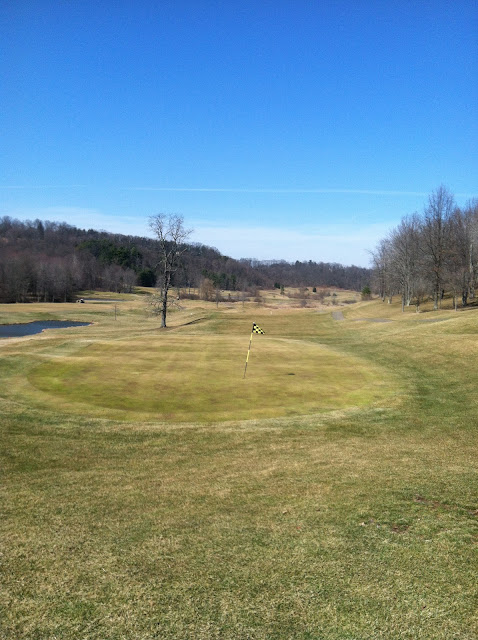(View of the eighteenth hole from the clubhouse. It's a reachable par five whose green blends into the hill behind it. The slope is clearly visible from the fairway, so don't be above the hole.)
John routed it in the valley below the clubhouse. The front nine is well done and takes advantage of the features and natural topography.
(A pic from the back of #2 green. Look at the wetlands in the crease of the valley. The holes literally play on the slopes above, offering beautiful vistas across the valley floor to the holes playing on the other side.)
(The double dogleg first hole has water and sand protecting it. Long hitters can cut off a lot of yardage by carrying the water from the tee, and then over all the trouble seen above. Birdie is a well deserved.)
(The long par four fourth is the only hole that plays on both sides of valley, as players drive from an elevated tee, down to the fairway, and then back uphill to an elevated green.)
(The fifth is a long downhill par three. The wind typically comes from the left, bringing the water more into play than one might expect. Notice the third hole in the background. It's these long views that one remembers after the round.)
(The par five sixth dips into the wetlands with a penisula green that is nearly surrounded by water. The only drawback is the ill advised placement of the cart path.)
I don't have a picture of my favorite hole on the front, the par four seventh. It ambles away from the valley, up the hill. It is bunkerless, tho water guards short right of the green, and when one is hitting a long iron or hybrid approach, that water looms in ones head. It's a beautiful hole.
(I wish the picture showed the cut/fill here at the ninth. The green is surrounded by mounds (I'm standing on it as I took the pic) and it looks and feels artificial in my opinion. Another great view of the valley!)
The clubhouse sits atop a hill, and it's the only natural feature that the back nine gets to use. Several of the holes are on the valley floor, and the flat terrain is lacking. Robinson tried to minimize this by having the tenth tee high on the hill, eleventh green mid-way up, and the eighteenth green at the base. Unfortunately the last three holes all play on the valley floor, and the course peters out as the round finishes.
(The par three twelfth plays across the slope of the hill. The aggressive line is all carry, while those who are unsure play to the front left corner where a flat spot might give an opportunity to up n down.)
(The panoramic views from thirteen tee is the highlight on the back. The hole itself is a bit awkward, and players have to decide what angle and yardage is best to attack the pin. Getting the correct distance on the approach is much easier thanks to lasers. Otherwise it's a difficult club selection.)
Driving to Oak Shadows is a commitment. From Canton, it's thirty minutes. When you see Wiltshire, it's still another twenty minutes! John Robinson designed several courses in Ohio between the '90s and 2000s, and I believe this may have been the first one. I think he did a good job here, and if the back nine was as good as the front nine, then Oak Shadows could be top twenty in Ohio. I give the course a 4 (above average) which I somewhat feel is low, but I realized I like the course because it's secluded; it's beautiful. And that experience is why I drive seventy five minutes to play here.

















































